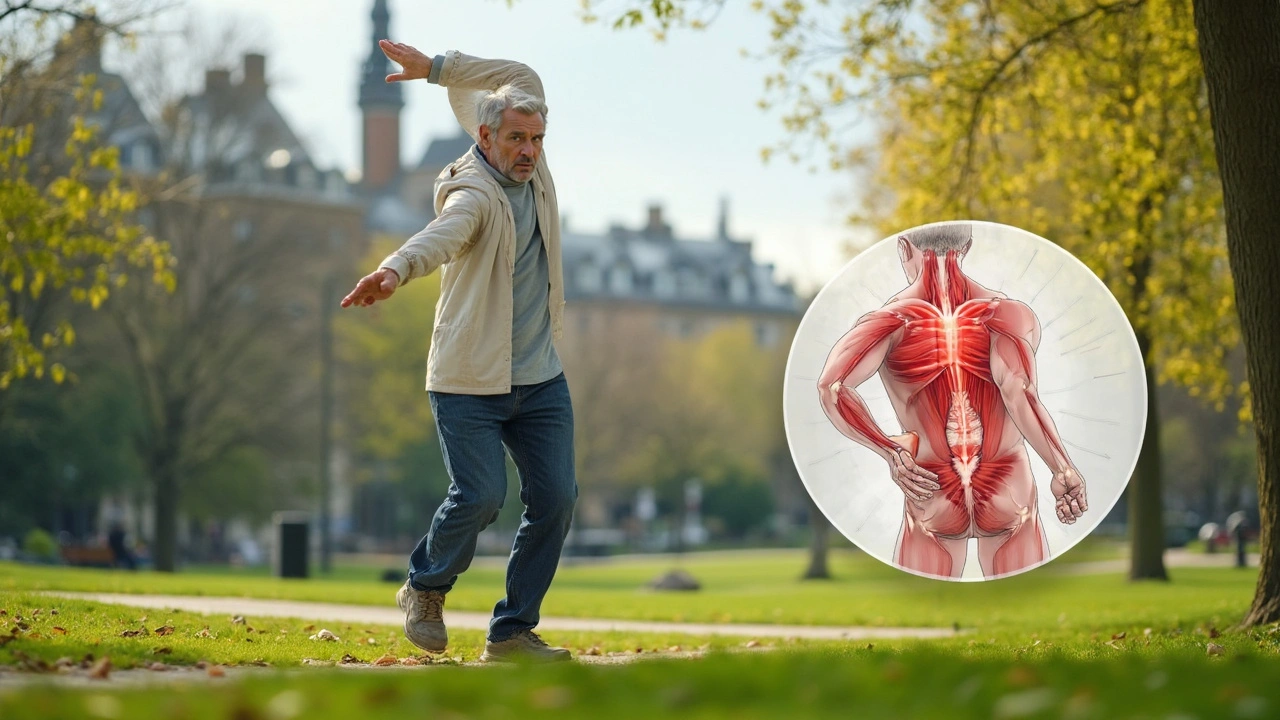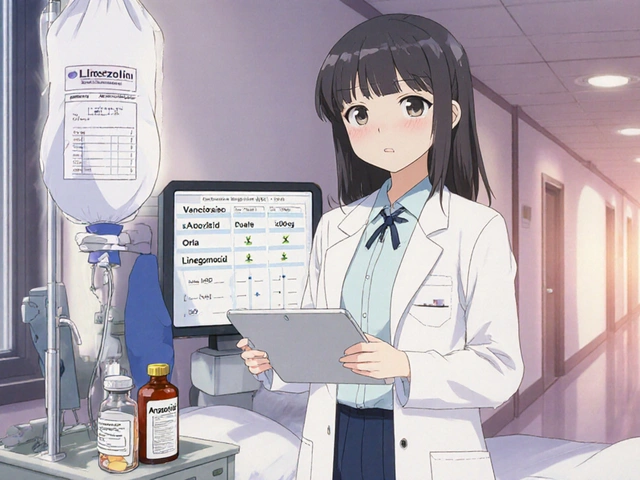You tweak your back picking up a laundry basket, and suddenly, you can’t bend over without wincing. A simple chore derails your day. Most folks think about muscle relaxants like Skelaxin when they hit these rough patches. But what makes Skelaxin different, and why do some doctors go straight for it instead of other options? This isn’t just another pain pill – it’s a little more complicated than that, and a lot of myths are floating around out there.
What Skelaxin Is and How It Works
Skelaxin, known by its generic name Metaxalone, has been around since 1962. It’s in a group of drugs called muscle relaxants, and doctors usually prescribe it for muscle pain or muscle spasms, especially after a strain or sprain. But here’s a twist: no one knows for sure exactly how Skelaxin works in the body. The label says it “may act in the central nervous system,” but the mechanisms are still somewhat of a mystery. That’s pretty rare in medicine these days, where most drugs come with a roadmap of how they function on a cellular level.
What we do know: Skelaxin seems to calm those sudden, sharp muscle contractions that follow injuries—like the kind you get from rearranging furniture or hauling around a squirmy toddler. It doesn’t directly relax muscles, though; instead, it's thought to work on your brain and spinal cord to tamp down signals that kick off pain and spasms. It’s usually taken in tablet form (400mg or 800mg) two to four times daily, with or without food, although fatty meals can actually make it hit your system faster and stronger—definitely something to note.
You might wonder how it stacks up against other muscle relaxants, like cyclobenzaprine or carisoprodol. Skelaxin stands out because it tends to have fewer side effects. Sedation, which is a huge complaint with most muscle relaxers, is notably milder with Skelaxin. This can be a gamechanger if you’re trying to manage pain without becoming a couch potato. In fact, a review in the journal Drugs found Skelaxin caused less drowsiness than many of its competitors, which is why doctors often offer it to folks who need to stay alert at work or take care of kids.
Despite its perks, Skelaxin isn’t for everyone. You shouldn’t take it if you have liver disease, since the drug is metabolized there—meaning your liver does the heavy lifting to break it down. Age matters too: the FDA hasn’t tested Skelaxin in kids under 12, and older adults may feel more of the sedative effects. And if you’re pregnant or breastfeeding, steer clear because we don’t really know what it does to babies.
Check out the table below for a quick snapshot of Skelaxin’s key facts compared to other popular muscle relaxants.
| Drug | Main Use | Common Side Effect | Prescribed For | Dose |
|---|---|---|---|---|
| Skelaxin (Metaxalone) | Muscle spasms, pain | Less sedation, dizziness, nausea | Adults & kids over 12 | 800mg, 2-4x/day |
| Cyclobenzaprine | Muscle spasms | Drowsiness, dry mouth | Short-term use in adults | 5-10mg, 3x/day |
| Carisoprodol | Muscle spasms | Drowsiness, risk of dependence | Adults (limited use) | 250-350mg, 3x/day and at bedtime |
| Baclofen | Muscle spasticity (neuro conditions) | Drowsiness, weakness | Adults & kids (careful dosing) | 5-20mg, 3-4x/day |
There’s a catch, though: Skelaxin isn’t a “cure” for your pain. It’s short-term help, designed to get you through acute muscle injuries. You take it for a week or two, paired with physical therapy or stretching, not as a long-term solution. This is because the real fix for muscle injuries comes from movement, rest, and time—not just from taking pills, no matter how tempting an easy fix might be.

When to Use Skelaxin and What to Expect
Cramping muscles in your lower back after you try to deadlift too much at the gym, or a neck twinge from sleeping wrong—these are exactly the kinds of moments when your doctor might pull out a Skelaxin prescription. It’s prescribed for acute muscle pain, not for chronic issues like fibromyalgia or for old injuries that keep flaring up. The goal is to cut down pain and spasms so that you can start gentle movements, get back to work, and avoid stiffness.
You’ll probably start feeling relief after one or two doses, but stay realistic: it’s not a magic bullet. Some people notice only mild pain relief, while others get enough help to get through the workday or finally sleep through the night. Grit your teeth and power through? That’s not really the smartest approach. Proper use can get you moving without pushing through agony.
If you’re new to muscle relaxants, keep an eye out for side effects: drowsiness, dizziness, headaches, and sometimes mild nausea. These usually mellow out after a few doses, but you shouldn’t drive or handle heavy machinery until you know how your body reacts. I’ve seen friends grab their first dose and assume they’re invincible, only to find themselves napping through soccer practice pickup. Lesson learned.
Dosing matters, too. Skelaxin should be spaced out regularly over the course of the day—not all at once. A lot of folks miss this and wind up with a wah-wah-wah crash in the afternoon. Since the drug gets absorbed faster with fatty food (think burgers or pizza), timing with meals can add an unexpected punch. If you get any unusual rashes, severe drowsiness, or trouble breathing, stop immediately and call your healthcare provider.
And here’s a pro tip: hydration and nutrition support muscle recovery more than people think. If you’re downing pain meds but ignoring water and protein, your muscles aren’t going to bounce back as fast as you’d hope. Gentle stretching or basic home exercises help too—ask your doctor or physical therapist for a plan. The medicine works better when combined with movement and a little patience.
Here are a few tips to get the most out of Skelaxin without running into trouble:
- Take it at roughly the same times daily—consistency helps keep muscle pain in check.
- If side effects hit hard, talk to your doctor about changing dose or timing before you quit.
- Don’t mix Skelaxin with alcohol or other sedatives. The drowsiness can add up fast.
- Tell your doctor about all other meds and supplements; even over-the-counter stuff can cause problems when mixed.
- Store Skelaxin at room temperature away from kids—especially curious little ones like my son Florian with his “What’s this?” phase.
Some folks ask if Skelaxin is addicting. While it’s not considered habit-forming in the way some muscle relaxants or painkillers are, there’s always a risk if you use it longer than prescribed. Stick to your provider’s advice, and don’t share your pills, even if your neighbor complains about the same back pain. Medicine works differently for everyone.
And if you’re ever unsure, track your symptoms in a simple notebook. Plenty of people spot patterns in their pain—maybe late-night TV marathons are making your muscles spasm, or your mattress needs a serious upgrade. This kind of info helps your doctor fine-tune your treatment or spot side effects fast.

Skelaxin in Real Life: Effectiveness, Controversies, and Smarter Pain Management
Let’s set the record straight. The evidence behind Skelaxin’s effectiveness mainly comes from studies comparing it to placebo. Those trials show that it does help with acute muscle pain—a 2010 analysis found it to be as effective as cyclobenzaprine at reducing symptoms, but much less likely to leave you snoozing midday. Unlike older muscle relaxants, though, Skelaxin isn’t used for spasticity in conditions like multiple sclerosis or after a stroke; it works best for run-of-the-mill strains and sprains.
But not everyone is thrilled about muscle relaxers in general. There’s a trend in modern medicine to avoid “just covering up” the pain. The American Academy of Family Physicians suggests reserving muscle relaxants, including Skelaxin, only when over-the-counter meds and physical therapy come up short. Why? Because long-term use doesn’t lead to better outcomes, and that drowsy haze from these meds can cause falls—especially in older adults.
Insurance coverage gets complicated too. Skelaxin, especially the brand-name version, is usually much pricier than generics like cyclobenzaprine. Always ask about the generic (Metaxalone), which costs less and works the same. If your pharmacy says it’s out of stock, ask if they’ll special order it—sometimes the supply chain hiccups make it vanish for a while.
Patients sometimes ask if natural alternatives can replace medications like Skelaxin. While some practices recommend magnesium, turmeric, or massages for muscle pain, there’s not much proof these substitute for prescription muscle relaxers during acute injury. Instead, the best combo is short-term medication with gentle movement and anti-inflammatory foods. I switched up my lunch to roasted salmon and a spinach salad after an old hockey injury, and I swear the recovery was smoother (or maybe I just like an excuse for a better lunch).
You can also try heat packs or cold compresses on tight muscles—20 minutes on, 20 minutes off. My daughter Isolde is always stealing my heating pad during her ballet rehearsals. Physical therapy helps prevent the pain from returning by fixing muscle imbalances. Skelaxin might get you through the rough patch, but retraining your muscles is the only way to keep back pain from swinging back later.
The bottom line: Skelaxin is a handy tool, but not a one-size-fits-all solution. It relieves muscle pain and spasms for most people with fewer side effects—especially less drowsiness—than many other options. But don’t expect it to “heal” your injury, and don’t plan on taking it forever. Use it as a bridge to gentle movement, good nutrition, smart self-care, and stronger muscles. When you treat muscle injuries with a bit more patience and a little less panic, you’ll do your body better in the long run.







11 Comments
Oh, look, another muscle relaxant to add to the potluck of meds that promise relief but come with a side of side effects. Skelaxin, huh? Metaxalone sounds fancy enough, but honestly, how effective is it really? I'm always skeptical with these muscle pain remedies—seems like a gamble between temporary relief and turning into a zombie from all the drowsiness.
Has anyone actually felt a lasting benefit from it rather than just placebo? And the risks—sounds like they love listing those tiny percentages of liver damage and allergic reactions to scare off the faint-hearted. It'd be great if some real-world feedback was around, not just the FDA speak.
I understand the skepticism, but from a clinical perspective, Metaxalone is often favored for its muscle relaxant properties with a comparatively better side effect profile than some alternatives. Of course, no medication is without risks, and each patient's condition and history must be considered.
I've seen patients respond positively, especially when combined with physical therapy and proper dosage adherence. It’s important not to rely solely on the medication but integrate holistic strategies.
Has anyone here tried combining Skelaxin with non-pharmacologic treatments? It would be insightful to discuss how these approaches complement each other.
Totally agree with the clinical considerations shared. Also, I’d like to mention that patient education is key when it comes to Skelaxin. Most people don’t realize you have to avoid alcohol due to increased drowsiness risk and potential liver stress.
Plus, timing your dosage around activities is crucial because it can make you pretty sleepy. A little planning goes a long way in managing side effects while getting relief.
On the bright side, many find it easier to get through the day when their muscle pain is under control, which can help with mood and sleep quality overall.
😩 Ugh, muscle pain is the worst!! I’ve been on Skelaxin for a couple weeks now and honestly, it’s been a bit of a lifesaver for me. The muscle stiffness was so bad I could barely move without pain.
Yes, it does make me sleepy sometimes, but I just take it when I’m home chilling and can nap if needed. Also, because I’m so sensitive, I was worried about side effects but so far I haven’t had anything crazy.
Anyone else feeling like a sleep monster while on this? 😂 But hey, if it means less pain and more Netflix time, I’m not complaining.
Sleep monster? More like walking dead for some! I’ve seen patients turn into total couch potatoes on Skelaxin, but hey, that’s the trade-off.
Just a heads-up though, folks tend to overlook liver warnings and end up regretting it. It’s savvy to get those liver enzymes checked if you’re on it long-term or mixing meds.
Also, be mindful about driving or operating anything dangerous. It’s not just about feeling drowsy; your reaction times slow down significantly.
Thanks for sharing these insights! I was prescribed Skelaxin recently, and while it’s relieving some of my muscle pain, I’m really cautious about the drowsiness. It messes with my day sometimes.
I appreciate the suggestion to avoid alcohol and the warning about liver enzymes—I had no idea it could be so serious over time.
Has anyone found effective ways to manage the sleepiness besides just napping? Like maybe adjusting diet or supplement timing? Would love to hear some tips.
Managing the drowsiness can be tricky, but for some folks, taking it right before bedtime helps a lot. The body can handle the sedative effect better when you're resting rather than active.
Also, staying hydrated and keeping a light meal before taking the meds might minimize gastrointestinal discomfort, which some forget is a common complaint.
Every patient is different, so it’s important to communicate with your doctor about how you’re feeling. Adjusting dose timing can make a big difference.
Look, I’m all for meds that work, but Metaxalone’s side effects sound like a party pooper. Imagine getting blasted with drowsiness just when you try to live your life! It’s like, you want relief, but then you gotta exist in a fog.
The thing about liver damage warnings? Yeah, those are your subtle tap on the shoulder saying, "You better be careful or this relief could come with a heavy price." I mean, why can’t muscle pain meds just chill out without wrecking other parts of us?
Anyway, if you use it, keep tabs on yourself and don’t ignore those early symptoms of liver issues. Better safe than sorry, right?
What if the big pharma companies are exaggerating the benefits and downplaying serious risks just to push Skelaxin like it’s the miracle cure? I mean, have you seen the flood of ads and sponsored posts? It’s fishy!
Those tiny print warnings about liver damage and allergic reactions? Probably grossly underreported or manipulated, no? They want our bodies dependent, but at what cost???
Wake up, people. Always question, always double-check before swallowing these pills blindly!!!
I appreciate all these views—it really shows how complex managing muscle pain with meds like Skelaxin can be. It reminds me that every person’s journey with pain relief is unique and must be approached thoughtfully.
In my perspective, it’s about finding balance: effective relief with minimal harm. We must listen to our bodies but also remain informed and consult experts.
To the original poster, thanks for putting together this info; awareness is key. And to everyone here sharing experiences and concerns—your voices matter in making informed health choices.
Thank you everyone for your thoughtful comments—it really helps to get various perspectives. I’m definitely going to be more cautious and speak more closely with my healthcare provider about monitoring and timing, as well as the risks mentioned.
It’s reassuring to know others have found some relief while also navigating the side effects. I think with the right care and attention, Skelaxin could be a helpful part of my pain management.
Looking forward to learning more and hearing if anyone else tries combining the medication with other therapies to get the best results.
Write a comment